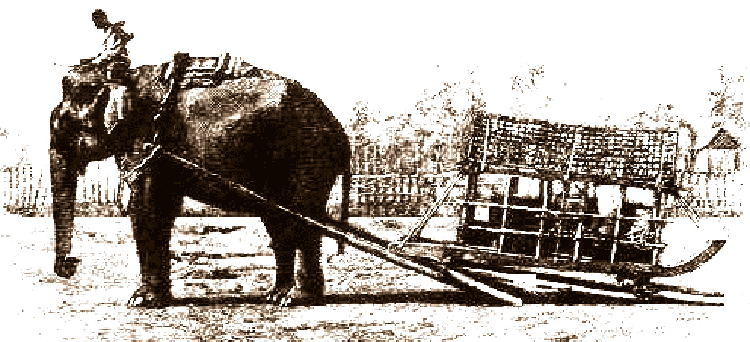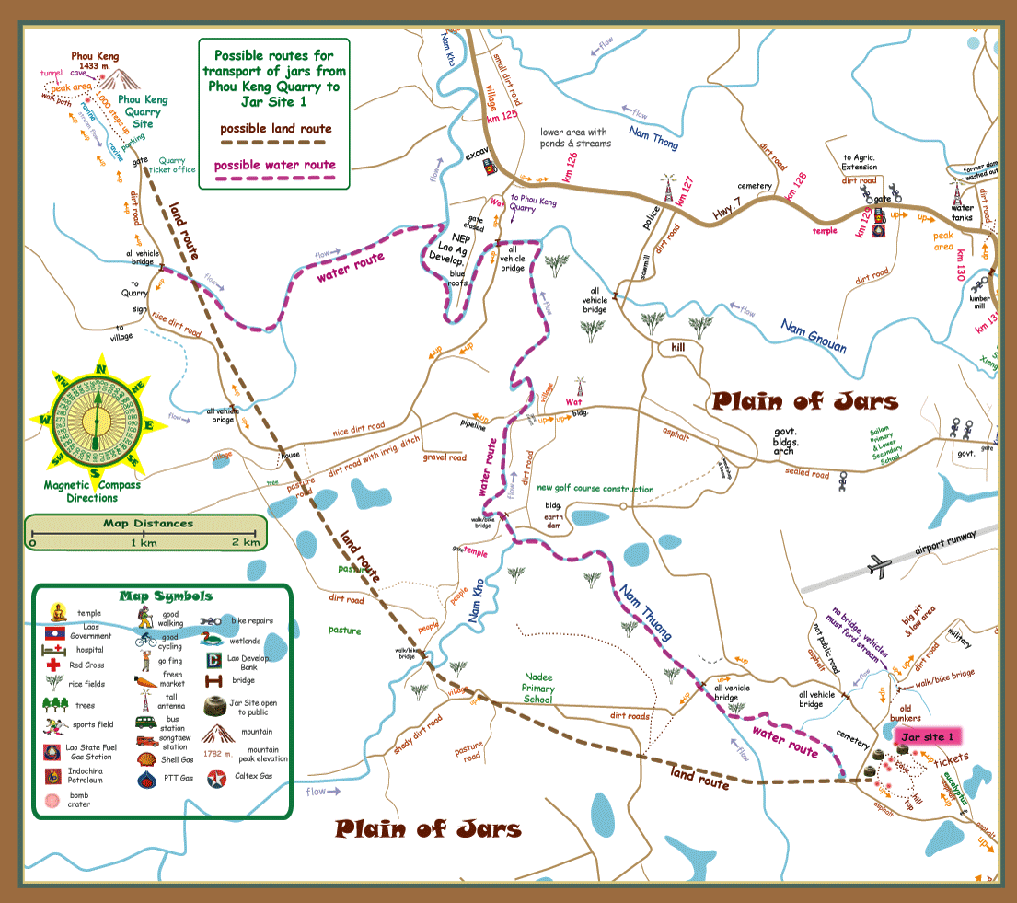
Transport of Jars at Plain of Jars, Laos - HoboMaps.com- Go to Plain of Jars Info Page - - - Home
It is generally agreed that all jars at the Plain of Jars (PDJ) have been carved out of solid rock and are very heavy.
In 2012 we measured the largest jars found at Jar Sites 1, 2, 3 and 16. Click HERE to see pictures of the largest jars we found at each site along with measurements and calculations of estimated weights. The transport weight for a jar would be its finished weight after the outer sides have been smoothed and the interior material has been removed.
Our measurements and weight calculations show that at least 90% of the jars at Sites 1, 2, 3 & 16 weigh less than 2,000 kilograms. It seems these jars could have been transported downhill or on a level surface by an elephant pulling a sled similar to the one in the illustration below. A team of oxen, bullocks or buffalo could probably have been used in place of an elephant.

Naturally-Situated Jar Boulders - At these 4 jar sites, less than 10% of jars may weigh more than 2,000 kilograms and might have been difficult to transport by an elepahant sled. Our theory is that most of these larger jars were carved from boulders already lying on the ground where ancient people found them and where we see them today and thus no transport was required. We think these large boulders may have been carried down from nearby higher mountains by ancient glaciers and deposited to where we see them today. We can't be sure that all of the jars were transported.
Water Channel Transport - For transport of jars from a quarry to a jar site located a few kilometers away it may have been helpful to use some form of water transport. A quarry located near a water channel might allow use of a raft or boat for transport by sliding or rolling a jar down onto the watercraft. Such transport might have included irrigation channels for rice fields or maybe even special water channels created solely for the purpose of moving jars to a jar site.
Former Lake Transport - There may have been a former lake existing at the PDJ long ago as the area is ringed by higher mountains and is rather flat with topsoil that seems sedimentary. Click HERE to see what areas may have been covered by a former lake.
After a jar had been carved at the quarry or boulder field it could have been slid downhill to the lake and onto a raft to float the jar to it's new site also near the shoreline. The distance a raft could easily travel on the lake would be unlimited and would open up the entire lakeshore and all islands in the lake for use as easily-accessible jar sites.
Water transport could have been done each year when the lake level was at its highest to minimize the distance from the quarry to the lakeshore and also to shorten the distance of uphill land transport to the jar site. An elephant pulling a sled could probably have handled this final uphill transport. Streams, rivers and irrigation water channels could also have played a transport role if connected to the lake.
Phou Keng Quarry - The only quarry identified as a source of jars for the 4 jar sites we visited in 2012 was the Phou Keng Quarry site which is believed to be a source for some of the jars at Jar Site 1. The term "Quarry" may be misleading since the Phou Keng Quarry is actually just a boulder field with naturally-situated boulders lying about on or near the surface.
When viewing the unfinished jars at the Phou Keng Quarry site we see that jar-finishing work was being conducted at this site. It seems likely that only finished jars were transported and that unfinished blocks or boulders were not transported due to their greater weight.
The map below shows possible land and water transport routes from Phou Keng Quarry site to Jar Site 1 about 10 kilometers away. The quarry is at a higher elevation than Jar Site 1 and the land route would be mostly over flat terrain without any natural obstructions to overcome other than crossing two rivers and two streams.

We might wonder if some of the jars would have been too heavy for water craft transport long ago but it seems this would not have been a problem in the 1880s as reported by James McCarthy in his excellent publication "Surveying and Exploring in Siam". If they could transport 3 elephants at one time back then on a hastily-constructed raft over a big river not far from the PDJ, it seems possible a single jar weighing less than 2,000 kilograms could have been transported on or over smaller rivers in earlier times.
McCarthy quote from page 39 - "It was interesting to observe the behaviour of the elephants when they were being sent across the river. Some swam over quietly enough; some, after making an emphatic protest, gave way; but there were others that could not be impelled, even by goading with spars or by the application of fire - they rushed back, and nothing could force them over. For these the men had recourse to another process. Having lashed together three ordinary dug-outs, they laid spars across them, about 4 feet long and 3 inches in breadth and thickness, and on these placed a flooring of 1-inch planks, covering the whole with plantain stalks and other fodder. I was doubtfully considering whether this extemporized raft was strong enough to bear even one elephant when, to my surprise, three walked on board and were safely carried to the other side."